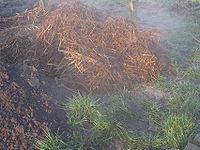Copsin
Copsin is an antimicrobial polypeptide secreted from the inky cap mushroom, first reported at the end of 2014. The fungal defensin acts against gram positive bacteria.
History

In October 2014, a collaboration of the Swiss Federal Institute of Technology, Switzerland and the University of Bonn, Germany reported, that they had identified a new antimicrobial peptide, excreted from the inky cap mushroom (Coprinopsis cinereacopsin) grown on horse dung.[1]
Biosynthesis

The polypeptide was recombinantly produced in a yeast named Pichia pastoris[1] which grew over five days. the peptide has an extremely compact three-dimensional structure on NMR spectroscopy.[2]
Mechanism of action
Copsin is an inhibitor of cell wall synthesis by binding to Lipid II[3]. It was reported to be potent in the petri dish against Gram positive bacteria which have a cell wall, including Enterococcus faecium and Listeria monocytogenes. It is not active against bacteria with an outer membrane, such as gram negative bacteria.[1]
Potential use
The "exceptionally stable protein", can be boiled at 100 degrees Celsius, can be mixed in strong acid for hours, and can also survive very aggressive enzymes, " remaining completely active". It is considered for use in the food industry for food preservation.[1]
See also
References
- ^ a b c d Essig A, Hofmann D, Münch D, et al. (12 December 2014). "Copsin, a novel peptide-based fungal antibiotic interfering with the peptidoglycan synthesis". J Biol Chem. 289 (50): 34953–64. doi:10.1074/jbc.M114.599878. PMC 4263892. PMID 25342741.
{{cite journal}}: CS1 maint: unflagged free DOI (link) - ^ "Copsin antibiotic found in mushroom that grows on horse dung". CBC News. Thomson Reuters. 12 December 2014. Retrieved 17 March 2015.
- ^ Franzoi, Marco; van Heuvel, Yasemin; Thomann, Susanne; Schürch, Nadia; Kallio, Pauli T.; Venier, Paola; Essig, Andreas (2017-09-19). "Structural Insights into the Mode of Action of the Peptide Antibiotic Copsin". Biochemistry. 56 (37): 4992–5001. doi:10.1021/acs.biochem.7b00697. ISSN 0006-2960.
